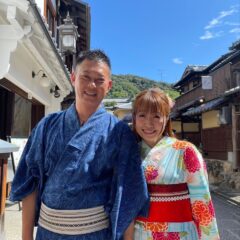Perfect for Formal Occasions! How to Choose a Visiting Kimono

Attending a formal occasion in Japan calls for the elegant attire of a kimono. Whether it’s a wedding, tea ceremony, or another special event, selecting the right visiting kimono is essential to make a lasting impression. In this guide, we’ll explore the key considerations and steps to choosing the perfect visiting kimono for formal occasions.
Table of Contents
- Introduction
- Embracing Elegance with a Visiting Kimono
- Understanding Visiting Kimono
- Definition and Purpose
- Importance of Proper Attire for Formal Occasions
- Choosing the Right Visiting Kimono
- Style and Design
- Fabric and Quality
- Color and Pattern
- Accessories and Accents
- Obi Selection
- Obidome and Obijime
- Hair Accessories and Footwear
- Fitting and Alterations
- Importance of Proper Fit
- Seeking Professional Assistance
- Etiquette and Cultural Considerations
- Respecting Tradition and Custom
- Following Dress Codes
- Conclusion
- Making a Graceful Impression with Your Visiting Kimono
Introduction
Prepare to exude grace and sophistication as you select the perfect visiting kimono for your formal occasion in Japan. Let’s explore the intricacies of choosing attire that reflects elegance and respect for tradition.
Understanding Visiting Kimono
Definition and Purpose
A visiting kimono, or “furisode” for unmarried women, is a traditional Japanese garment worn on special occasions. It symbolizes grace, elegance, and respect for the event and its participants.
Importance of Proper Attire for Formal Occasions
Wearing the appropriate visiting kimono demonstrates reverence for the occasion and hosts, showcasing cultural appreciation and etiquette.
Choosing the Right Visiting Kimono
Style and Design
Consider the formality of the event when selecting a kimono style. Furisode with long sleeves signifies youth and celebration, while more subdued colors and patterns may be appropriate for somber occasions.
Fabric and Quality
Opt for high-quality fabrics such as silk, which drapes gracefully and enhances the kimono’s elegance. Pay attention to craftsmanship and details like embroidery and hand-painted motifs.
Color and Pattern
Choose colors and patterns that complement your complexion and personal style. Vibrant hues like red and deep blue convey energy and sophistication, while subtle floral motifs exude femininity and grace.
Accessories and Accents
Obi Selection
Select an obi that complements your kimono and enhances your silhouette. Formal occasions may call for a wide and elaborate obi tied in intricate knots, while simpler styles are suitable for casual events.
Obidome and Obijime
Accentuate your obi with decorative accessories like obidome (brooches) and obijime (cord). Choose pieces that harmonize with your kimono’s color scheme and add a touch of elegance to your ensemble.
Hair Accessories and Footwear
Complete your look with traditional hair ornaments and footwear. Elegant kanzashi (hairpins) and zori sandals or geta shoes enhance the overall aesthetic of your kimono attire.
Fitting and Alterations
Importance of Proper Fit
Ensure your visiting kimono fits comfortably and flatters your figure. A well-fitted kimono enhances your posture and movement, allowing you to exude confidence and grace.
Seeking Professional Assistance
Consult with kimono specialists or experienced dressers for fitting and alterations. They can provide valuable guidance on adjustments to achieve the perfect fit and silhouette.
Etiquette and Cultural Considerations
Respecting Tradition and Custom
Adhere to cultural norms and etiquette when wearing a visiting kimono. Pay attention to proper posture, bowing, and gestures to show respect and appreciation for Japanese tradition.
Following Dress Codes
Observe any dress codes or guidelines provided for the event. Respect the host’s wishes and adhere to formalities to ensure a harmonious and respectful atmosphere.
Conclusion
Selecting the perfect visiting kimono for a formal occasion in Japan is a thoughtful process that reflects reverence for tradition and appreciation for cultural heritage. By considering style, quality, and etiquette, you can make a graceful impression and honor the significance of the event with your elegant attire.


